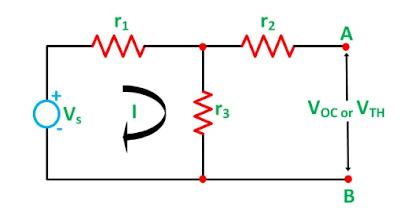Thevenin's Theorem expresses that any confused system over its heap terminals can be subbed by a voltage source with one obstruction in arrangement. This hypothesis helps in the investigation of the variety of current in a specific branch when the opposition of the branch is differed while the rest of the system continues as before.
For example in planning electrical and gadgets circuits.
A progressively broad explanation of Thevenin's Theorem is that any straight dynamic system comprising of autonomous or ward voltage and current source and the system components can be supplanted by a proportionate circuit having a voltage source in arrangement with an opposition.
Where the voltage source being the open-circuited voltage over the open-circuited load terminals and the obstruction being the inner opposition of the source.
As it were, the current moving through a resistor associated over any two terminals of a system by a proportional circuit having a voltage source Eth in arrangement with a resistor Rth. Where Eth is the open-circuit voltage between the necessary two terminals called the Thevenin voltage and the Rth is the identical obstruction of the system as observed from the two-terminal with every other source supplanted by their inward protections called Thevenin opposition.
Contents:
- Explanation of Thenvenin Theorem
- Steps For Solving Thenvenin Theorem
Explanation of Thevenin’s Theorem
The Thevenin's announcement is clarified with the assistance of a circuit demonstrated as follows:
Let us consider a basic DC circuit as appeared in the figure above, where we need to discover the heap current IL by the Thevenin's hypothesis.
So as to locate the equal voltage source, rL is expelled from the circuit as appeared in the figure beneath and Voc or VTH is determined.
So,
Presently, to locate the inner opposition of the system (Thevenin's obstruction or proportional obstruction) in arrangement with the open-circuit voltage VOC , otherwise called Thevenin's voltage VTH, the voltage source is evacuated or we can say it is deactivated by a short out (as the source doesn't have any interior obstruction) as appeared in the figure underneath:
Therefore,
According to Thevenin's Statement, the heap current is controlled by the circuit appeared above and the proportional Thevenin's circuit is gotten. The heap current IL is given as:
Where,
VTH is the Thevenin's proportionate voltage. It is an open circuit voltage over the terminal AB known as burden terminal
RTH is the Thevenin's proportional opposition, as observed from the heap terminals where all the sources are supplanted by their inner impedance rL is the heap obstruction
Steps for Solving Thevenin's Theorem
Stage 1 – First of all expel the heap opposition rL of the given circuit.
Stage 2 – Replace all the sources by their interior opposition.
Stage 3 – If sources are perfect at that point hamper voltage source and open circuit the current source.
Stage 4 – Now locate the proportional obstruction at the heap terminals, known as Thevenin's Resistance (RTH).
Stage 5 – Draw the Thevenin's proportionate circuit by interfacing the heap opposition and after that decide the ideal reaction.
This hypothesis is perhaps the most broadly utilized systems hypothesis. It is material where it is wanted to decide the current through or voltage over any one component in a system. Thevenin's Theorem is a simple method to settle a confounded system.
Related Terms:-













No comments:
Post a Comment
If you have any Doubt, Please let me know